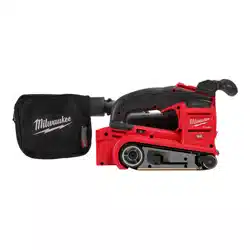Loading ...
Loading ...
Loading ...

4
WARNING
Collected sanding dust from sand-
ing surface coatings such as
polyurethanes, linseed oil, etc. can self-ignite in
the sander dust bag or elsewhere and cause re.
To reduce the risk of re always empty the dust
bag frequently (10-15 minutes) while sanding and
never store or leave a sander without totally
emptying its dust bag. Also follow the recom-
mendations of the coatings manufacturers.
Do not use the dust bag when sanding metal. This
causes a re hazard and can result in serious injury.
Using the Dust Bag
The dust bag provides a dust collection for the
sander. To use the dust bag:
1. Remove battery pack.
2. To insert, push the tab in the open position while
sliding the dust bag adapter into the sander's
dust port.
3. To remove, push the tab in the open position
while pulling the dust bag away from the sander's
dust port.
4. To empty, unzip the dust bag. Empty dust from
the dust bag holding away from the user's face
and tapping dust bag into a trash can, pail or other
reasonable container. Do not clean dust bag with
water or compressed air.
For more ecient operation, empty the dust bag
when it is no more than half full. This will allow the
air to ow better through the dust bag. Always
empty thoroughly upon completion of a sanding
operation and before storing the sander.
WARNING
When sander is not connected to
vacuum, always reinstall dust bag
assembly back onto sander. Failure to do so
could cause sanding dust or foreign objects to
be thrown into face or eyes which could result in
possible serious injury.
Universal Hose Adapter
Use the universal hose adapter to attach the sander
to a vacuum hose.
1. Remove the battery pack.
2. Remove the dust bag from the sander.
3. To insert, slide the universal hose adapter into the
sander's dust port. Push sander and adapter togeth-
er rmly. Connect the vacuum hose to the adapter.
4. To remove, disconnect the vacuum hose from the
adapter. Then, grasp the sander and adapter rmly
and pull apart.
OPERATION
WARNING
To reduce the risk of injury, always
wear proper eye protection marked
to comply with ANSI Z87.1.
When working in dusty situations, wear appro-
priate respiratory protection or use an OSHA
compliant dust extraction solution.
To reduce the risk of injury, keep hands and body
away from a moving sanding belt. Do not wear
loose clothing or jewelry when operating sander.
They could get caught in moving parts causing
serious injury. Keep head away from sander and
sanding area. Hair could be drawn into sander
causing serious injury.
Speed Dial
The speed dial allows the sander to operate at vari-
able speeds - from low speed (1) to high speed (5).
1. To increase speed, turn the dial to a higher setting.
2. To decrease speed, turn the dial to a lower setting.
CAUTION
Make sure to match the direction
of the rotation with the sanding
belt. Failure to do so can create a hazardous
situation.
4. Push the belt tension lever back in.
5. Follow instructions on "Adjusting Sanding Belt
Tracking".
WARNING
Fingers can be pinched between
the rollers and the belt tension
release. To reduce the risk of injury, keep ngers
out of the areas.
Adjusting Sanding Belt Tracking
After installing a new sanding belt, it is best practice
to adjust the sanding belt tracking. This may take sev-
eral times to properly condition the new sanding belt.
Adjusting the sanding belt tracking regularly will
increase the belt life.
1. Insert battery pack.
2. Position the sander upside down.
3. Pull the trigger.
4. The outer edge of the base of the sander should be
even with the sanding belt when properly adjusted.
The sanding belt should not show excessive wear
on the inner edge. The sanding belt may be rub-
bing against internal components. If this occurs,
adjust the sanding belt tracking. Depending on
the placement of the sander belt choose between:
Adjusting sanding belt inward: Slowly twist the belt
adjuster knob counterclockwise.
Adjusting sanding belt outward: Slowly twist the
belt adjuster knob clockwise.
Selecting Sandpaper and Grits
Sandpaper can be made from various grit materials
and these should be selected according to the mate-
rial to be sanded. The guidelines below list materials
and grit materials that should be used with them.
• Fine woodwork – garnet or aluminum oxide
• Rough woodwork – aluminum zirconia or ceramic
aluminum oxide
• Manufactured wood products (particleboard,
medium density ber board, etc.) – silicon carbide
or aluminum oxide
• Solid surface materials (Corian
®
, quartz, granite,
etc.) – silicon carbide or aluminum oxide
• Metals – emery or aluminum oxide
Sandpaper is also graded by coarseness. Start your
work with an abrasive grit just coarse enough to re-
move high spots and excessive roughness. Follow
with a second sanding using a grit one or two grades
ner. Continue with successively ner grits until you
obtain the desired nish.
Do not switch from a coarse grit to a very ne grit in
one step because it may be dicult to remove the
marks made by the coarse grit abrasive. Use the
nest grits practical for the roughing operation, and
nish by using successively ner grits.
Grit Type Typical Application
80 or
less
Course
Ideal for initial sanding on rougher
surfaces. For fast stock removal.
Rough sanding and stripping of
painted and rusted surfaces.
100
120
Medium
For intermediate sanding and removal
of minor surface imperfections.
150
180
220
Fine
Ideal for ne sanding prior to
staining, priming, or sealing.
Loading ...
Loading ...
Loading ...
